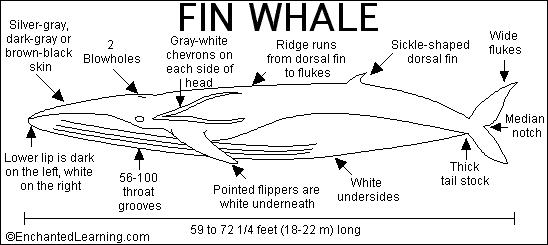
 |
| You might also like: | Dall's Porpoise Printout - ZoomWhales.com | Whale Myths | Whale Extremes | Gray Whale Print-out | Whale Book (Cover) | Today's featured page: Keel-Billed Toucan Read-and-Answer Quiz |
| Whale Printouts | Fin Whale | Animal Printouts Label Me! Printouts |


The fin whale is a streamlined whale that is found worldwide except in polar waters; it is most common in the Southern Hemisphere. There are three separate populations of fin whales, one in the northern Pacific, one in the North Atlantic, and one in the Southern Hemisphere; they do not interbreed. Many groups of fin whales migrate between feeding grounds and breeding grounds. This whale usually swims in pods of 3-7 whales but larger groups (up to 300 animals) may form at rich feeding grounds or while migrating.
The fin whale is also called the finback, finner, razorback, common rorqual, and herring whale.
Anatomy: The fin whale has an asymmetrical head; the bottom lip is dark on the left side and white on the right side. Fin whales grow to be about 59 to 72 1/4 feet (18-22 m) long and weigh about 30 to 80 tons. The females are slightly larger than the males, as with all baleen whales. Calves weigh about 2 tons at birth!
Diet and Baleen: Fin whales are carnivores that filter-feed plankton (tiny crustaceans like krill, copepods, pteropods, etc.) and small fish from the water. They have very fine grey-black baleen that traps very small particles of food. Each side of the upper jaw has 350-400 baleen plates.
| Search the Enchanted Learning website for: |